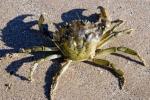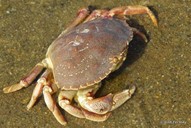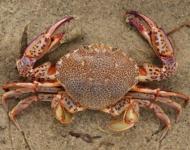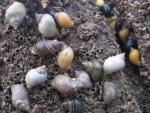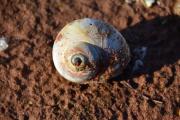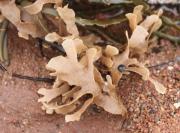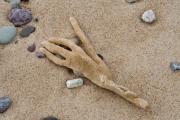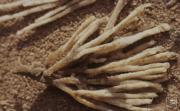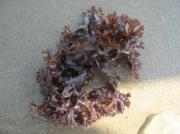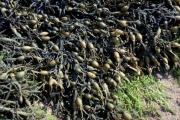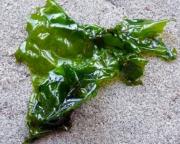Fundy Field Notes: Who’s Living on the Tidal Flats?
As most of us already know, the Bay of Fundy is home to the highest tides in the world, bringing in approximately 160 billion tons of water twice a day and exposing kilometers of muddy tidal flats. But have you ever wondered what could be living in these tidal flats?
The tidal flats along the Bay of Fundy are home to a multitude of creatures- the key word being home. When exploring the tidal flats, you should keep this in mind. When turning over rocks, picking up shells or walking through tidal pools you should always put things back where you found them and watch where you are stepping. This is because someone, or something is living there. Imagine watching TV in your living room and a giant came and took the roof off your house to look in, you probably wouldn’t mind if they put your roof back, but if the giant threw your roof down the street you might be bothered. Well, the crabs feel the same way.
Speaking of crabs, there are three common species of crabs you can find while exploring the shoreline:
|
European Green Crab |
Rock Crab |
Lady Crab |
|
|
|
|
|
Image retrieved from: www.critterfacts.com This crab is an invasive species and is considered to be one of the ten most unwanted species in the world according to the Department of Fisheries and Oceans. Although this may be true, I have always found them pleasant to be around. |
Image retrieved from: www.joshfecteau.com The rock crab is reddish in colour with tiny speckles. You will likely find this crab hiding under rocks or hanging out in tide pools. |
Image retrieved from: www.pic.roysfarm.com The most aggressive of the three, the lady crab is also red with speckles. However, the speckles form a leopard-like pattern on the shell making it quite distinctive. And no, not all lady crabs are ladies. |
| Hermit Crab |
Dog Whelk |
Moon snail |
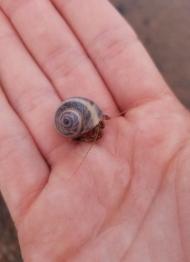 |
|
|
| Of course, we cannot forget about the fan favourite - the hermit crab. Hermit crabs come in all shapes and sizes because they make their home in empty shells from other critters. Some shells you can find hermit crabs in are: whelk shells, moon snail shells, periwinkle shells and sometimes limpet shells. Hermit crabs can be found cruising around tidal pools and munching on bivalves or other scraps they can get their tiny pincers on. |
Image retrieved from: www. en.wiktionary.org The dog whelk is a small carnivorous sea snail and comes in many different colours. If you ever see an empty shell with a small hole in it, it was likely a whelk’s lunch. |
Image retrieved from: www.peinaturetracker.ca Moon snails like to hang out on sandy or muddy substrate. It is somewhat rare to find a living moon snail because they rarely live in rocky areas, but you can commonly find their shells on the beach. |
|
Periwinkle |
Slipper Limpet |
Leafy Bryozoan |
|
|
|
|
|
Image retrieved from: www.seashoretoforestfloor.com You can typically find periwinkles in colonies along rocky areas and tide pools. If you happen to see some, they are likely grazing on a variety of algae. |
Image retrieved from: www.getoutmore.uk/ You can find slipper limpets attached to rocks in the tidal zone. |
Image retrieved from www.bruntcoatheadpark.ca Now, I would like to share my favourite organism with you. It is called leafy bryozoan. It looks like seaweed, but it is actually an animal. They are formed by colonies of tiny individuals called zooids. The really cool thing about leafy bryozoan is that it smells like lemon (if you find a fresh piece). The fresher the piece the stronger the lemon smell. Leafy Bryozoan is formed by colonies of tiny individuals called zooids and are the coolest organisms on the seashore. |
A few more living things you can find include:
|
Dead Man’s Fingers |
Mermaid’s Glove |
Irish Moss |
|
|
|
|
|
Image retrieved from: www.flickr.com Thought to have evolved 500 million years ago, this sponge can be found washed up on the beach and used to prank your friend. |
Image retrieved from: www.flickr.com If this isn’t proof that mermaids exist, I don’t know what is. |
Image retrieved from: www.thecanadianencyclopedia.ca This common seaweed is used to make carrageenan which is used in ice cream, toothpaste and beer/wine. |
|
Knotted Wrack |
Sea Lettuce |
|
|
|
|
Image retrieved from: www.sciencephoto.com Knotted wrack provides a home to snails, shrimp, fish, and mussels. You can tell the age of knotted wrack as they lay down one air bladder per growing season. |
Image retrieved from: www.vichighmarine.ca Sea lettuce is a type of green algae and is sometimes dried and eaten. But be careful, on the beach it can be very slippery, so watch your step! |
So, the next time you are walking along the tidal flats on the Bay of Fundy be sure to watch your step, you might just be walking in somebody’s home.
About the author
Ryley Crowe is a recent graduate from Acadia University completing a Bachelor of Science in Environmental Geoscience. Ryley has spent the past seven summers working as an interpretive guide at a variety of places from Burntcoat, Nova Scotia to Banff, Alberta. She is now working at the Fundy Geological Museum as a curatorial assistant. You can find her walking her dog Goji around the town of Parrsboro or on the lake with her paddle board.
